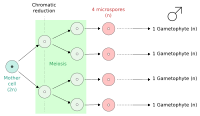Spore
In biology, a spore is a reproductive structure that is adapted for dispersion and surviving for extended periods of time in unfavorable conditions. Spores form part of the life cycles of many plants, algae, fungi and some protozoans.
Spores are usually haploid and unicellular and are produced by meiosis in the sporophyte. Once conditions are favorable, the spore can develop into a new organism using mitotic division, producing a multicellular gametophyte, which will eventually go on to produce gametes. Two gametes fuse to create a new sporophyte. This cycle is known as alternation of generations however "Biological Life Cycle" is a better term as there may be more than one phase and it cannot therefore be an "alteration" of anything. Haploid spores produced by mitosis (known as mitospores) are used by many fungi for asexual reproduction.
It is useful to contrast spores with gametes: spores are the units of asexual reproduction as a single spore develops into a new organism; gametes are the units of sexual reproduction as two gametes need to fuse to create a new organism.
The term spore may also refer to the dormant stage of some bacteria or archaea; however these are more correctly known as endospores and are not truly spores in the sense discussed in this article. The term can also be loosely applied to some animal resting stages. Fungi that produce spores are known as sporogenous, and those that do not are asporogenous.
The term derives from the ancient Greek word σπορα, meaning seed.
Classification of spores
Spores can be classified in several manners.
By function
Diaspores are dispersal units of fungi, mosses, ferns, fern allies, and some other plants. In fungi, chlamydospores are thick-walled resting spores, and zygospores are thick-walled resting spores (hypnozygotes) of zygomycetous fungi which are produced by sexual gametocystogamy and can give rise to a conidiophore ("zygosporangium") with asexual conidiospores.
By spore-producing structure
In fungi and fungus-like organisms, spores are often classified by the structure in which meiosis and spore production takes place, such as a telium, ascus, basidium, or oogonium, which produce teliospore, ascospores, basidiospores, and oospores, respectively. Since fungi are often classified according to their spore-producing structures, these spores are often characteristic of a particular taxon of the fungi, such as Ascomycota or Basidiomycota.
By origin during life cycle
Meiospores are the product of meiosis (the critical cytogenetic stage of sexual reproduction), meaning that they are haploid, and will give rise to a haploid daughter cell(s) or a haploid individual. An example is the parent of gametophytes of the higher vascular plants (angiosperms and gymnosperms)—the microspores (give rise to pollen) and megaspores (or macrospores) (give rise to ovules) found in flowers and cones; these plants accomplish dispersal by means of seeds.
A mitospore (conidium, conidiospore) is an asexually produced propagule, the result of mitosis. Mos t fungi produce mitospores. Mitosporic fungi are also known as anamophic fungi (compare teleomorph or deuteromycetes).
By motility
Spores can be differentiated by whether they can move or not. Zoospore can move by means of one or more flagellum and can be found in some algae and fungi. Aplanospore cannot move, but may potentially grow flagella. Autospore cannot move and do not have the potential to ever develop any flagella. Ballistospore are actively discharged from the body of a fungal fruit (such as a mushroom). Statismospore are not actively discharged from the fungal fruit body, similarly to a puffball.
Parlance
In common parlance, the difference between "spore" and "gamete" (both together called gonites) is that a spore will germinate and develop into a sporeling, while a gamete needs to combine with another gamete before developing further. However, the terms are somewhat interchangeable when referring to gametes.
A chief difference between spores and seeds as dispersal units is that spores have very little stored food resources compared with seeds, and thus require more favorable conditions in order to successfully germinate. Spores, therefore, are more resistant to harsh conditions and require less energy to start mitosis. Spores are usually produced in large numbers to increase the chance of a spore surviving.
The endospores of certain bacteria are often incorrectly called spores, as seen in the 2001 anthrax attacks where anthrax endospores were incorrectly called anthrax spores by the media. Several key differences between bacterial endospores and eukaryotic spores exist: they are primarily a survival mechanism, not a reproductive method, and a bacterium only produces a single endospore.
Diaspores
In the case of spore-shedding vascular plants such as ferns, wind distribution of very light spores provides great capacity for dispersal. Also, spores are less subject to animal predation than seeds because they contain almost no food reserve; however they are more subject to fungal and bacterial predation. Their chief advantage is that, of all forms of progeny, spores require the least energy and materials to produce.
Vascular plant spores are always haploid and vascular plants are either homosporous or heterosporous. Plants that are homosporous produce spores of the same size and type. Heterosporous plants, such as spikemosses, quillworts, and some aquatic ferns produce spores of two different sizes: the larger spore in effect functioning as a "female" spore and the smaller functioning as a "male".
Under high magnification, spores can be categorized as either monolete spores or trilete spores. In monolete spores, there is a single line on the spore indicating the axis on which the mother spore was split into four along a vertical axis. In trilete spores, all four spores share a common origin and are in contact with each other, so when they separate each spore shows three lines radiating from a center pole.



